The Dalai Lama's new home away from home : Call of the Wild : Legal Matter : Unspeakable Acts : Winged Mystery : Fists of Fury : The Deadly Arts : Broadcasting for Beasts
The Dalai Lama's new home away from home
The Victorian house at 412 North Aurora Street looks like many others in Ithaca's Fall Creek neighborhood. It's got a porch swing, a well-tended patch of lawn, and a funky paint job— maroon with yellow trim. It's the activities inside that set it apart: classes, meditation sessions, and workshops on Tibetan Buddhism, all open to the public. The modest house is Namgyal Monastery, home to five monks—and the Dalai Lama's official headquarters in North America. But not for long. Namgyal is building a new monastic complex on South Hill, providing a venue more fitting for Tibet's spiritual and political leader, and giving the monks a more serene retreat. "Here, there's always something happening," says the Venerable Tenzin Gephel, Cornell's Buddhist chaplain, who has lived on Aurora Street since 1997. "Maybe it will be quieter over there, better for personal practices and meditation."
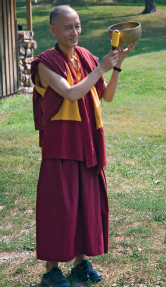
The project, jump-started by a $1 million donation from an anonymous Cornellian, will complete a circle begun in 1989, when the late Namgyal monk Pema Losang Chogyen came to Cornell to work with computer programmers on creating a three-dimensional virtual model of a mandala. Used as an aid to meditation, a mandala depicts an imaginary palace where Buddhist deities live. (The Sanskrit word actually means "house" or "palace.") Almost a decade later, Namgyal is now constructing a 13,000-square-foot bricks-and-mortar mandala, with four buildings surrounding a shrine hall in the middle of a central courtyard. The hall itself will also resemble a mandala. "With a lot of input from the monks, we explored the proportions and oriented the structure as if the mandala was extrapolated into three dimensions," says Lane Chambliss '68, an Ithaca architect who designed the monastery and is a Namgyal board member.
The new complex is called Dü Khor Choe Ling, or the Land of the Kalachakra Study and Practice. Kalachakra, which means "wheel of time" in Sanskrit, refers to a set of meditations where one works to gain control over recurring external and internal cycles, from the motion of the planets through the sky to the body's rhythm of breath. The Dalai Lama named the site and blessed it during his last visit, in 2007.
Designs for the $3 million project, located on twenty-eight wooded acres about a mile south of Ithaca College, call for a residence reserved for the Dalai Lama and quarters for eight monks. "The Aurora Street building can easily handle four resident monks. With a squeeze, you can get six in there," says David Holmberg '70, PhD '80, former chair of Namgyal's programming committee and current chair of Cornell's anthropology department. "But it's where they live. It really limits the amount of programming that the monastery can do."
So plans for community buildings include a shrine hall with seating for up to 120 people, a library with Buddhist texts in English and Tibetan, kitchen and dining areas, and rooms for classes and conferences. Those facilities, along with student housing—from four private rooms with kitchen and bath to five seasonal cabins each housing twenty people—will enable the monastery's Institute for Buddhist Studies to expand its programming. Plans are on the drawing board for larger and more frequent weekend intensives, and, for the first time, private retreats, in which individuals study on-site for a year.
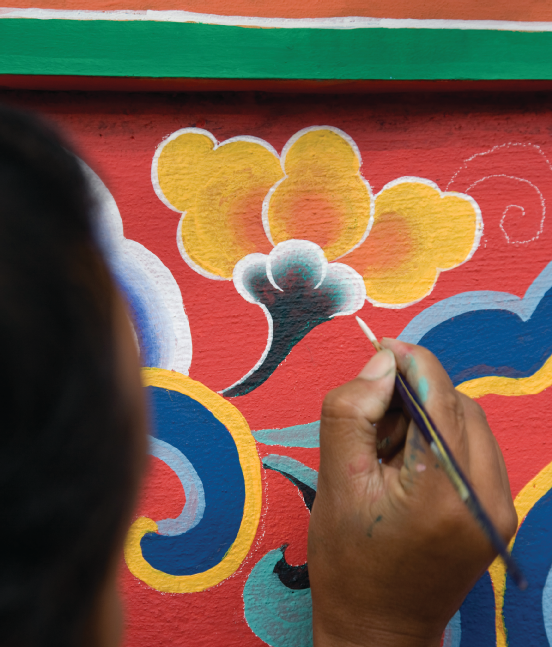
It was another meditation center, in Hector, that first drew the Dalai Lama to Upstate New York in 1979, on a visit arranged by Sidney Piburn, MFA '69. In 1991, the spiritual leader came to campus for three days as a Bartels World Fellow; it was about that time that Pema Losang Chogyen and some American friends proposed a Namgyal branch in Ithaca. The Dalai Lama approved. "He's very interested in increasing dialogue between science and Buddhism," says Holmberg. "Because of the educational community here, this seemed like an appropriate place to pursue those kinds of connections." The monastery's board has included Cornell faculty, such as Jane Marie Law, associate professor of Japanese religions, and film professor Don Fredericksen. Cornell students take monastery courses on the Tibetan language, which the University does not offer, as well as Buddhist philosophy; anthropology professor Kathryn March, PhD '79, regularly visits Aurora Street with her Peoples and Cultures of the Himalayas class.
If Namgyal is a unique presence in Ithaca, it's also unique among Buddhist monasteries. The order serves as the Dalai Lama's personal monastery, charged with assisting with his religious activities and performing ritual prayers and ceremonies. The original Namgyal Monastery was the famed Potala Palace in Tibet's capital, Lhasa. China took control of Tibet in 1951, and by 1959, the Dalai Lama fled Lhasa and re-established Namgyal in Dharamsala, India. Now Namgyal has three other outposts in India; the Ithaca branch is the only one in the West.
Construction for Dü Khor Choe Ling began in 2006, with infrastructure such as drainage and roads. Namgyal has enough resources only to enclose what will be the commons building and the shrine hall, Holmberg says, "and then we're out of money." But Namgyal's board has an incentive to raise the $2 million it needs to get the job done. "When the Dalai Lama was here, he said he would come back when it was finished," Holmberg says. "That gives us some motivation."
— Susan Kelley
Call of the Wild
Residency brings CU vet to the Bronx Zoo
Tim Georoff's job comes with housing—an apartment with a 265-acre backyard populated by more than 5,000 animals. As the Vet college's first clinical resident in zoo medicine, Georoff lives in the health center at the Bronx Zoo, where hundreds of species share an oasis of greenery within the urban jungle. "You can hear the peacocks at night," he says. "And if you have your window open, you might hear some animals in quarantine, like tigers and parrots. You can also hear the sirens and things that go on in the Bronx, so it's an interesting mix."
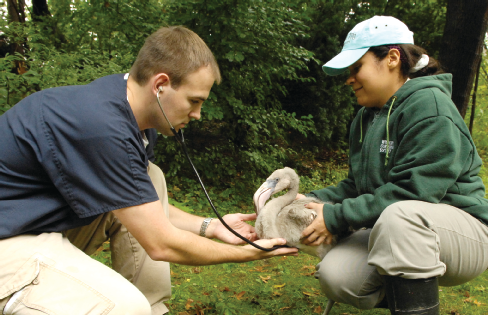
Georoff, who earned his DVM from the University of Pennsylvania in 2004, started at the zoo last July after a year on the Ithaca campus, which included work at the Rosamond Gifford Zoo in Syracuse. He spends his days helping to care for the 20,000 animals in the Wildlife Conservation Society (WCS) system—not only the flagship Bronx Zoo but menageries in Central Park, Prospect Park, and Queens, as well as the New York Aquarium on Coney Island. "It's a terrific clinical experience," he says. "We see so many cases and do so many things. Any day, I could be doing a C-section on a Maxwell's duiker—that's a type of antelope—or treating a fifteen-gram bird or a colony of tiny, endangered frogs. I could be working on a sick animal or moving healthy animals around the zoo. It's just so variable."
The residency is a three-year program. Georoff, who came to Cornell after previous residencies in small animal medicine and exotics, will stay at the Bronx Zoo until 2009, and another clinical resident will join him there this summer. (A related pathology residency keeps students in Ithaca for two years, then in the Bronx for one.) "The Bronx and affiliated zoos have a huge animal collection," says George Kollias, the Hyman Professor of Wildlife Health, who oversees the program. "The diversity of species is large, so they get exposed to things they might not see in Ithaca." The program got its initial funding from the Vet college, but Kollias notes that Cornell and WCS will ultimately have to seek outside support if it is to continue. WCS senior veterinarian Paul Calle calls the residency a boon for both institutions, which had been collaborating for years before formalizing the program. "Cornell is a world-class vet school with tremendous resources, and we've got this tremendous caseload," he says. "The question isn't why we're doing it, it's why we didn't do it until now."
On a balmy day last fall, Georoff and Calle are on their morning rounds, traveling around the zoo by motorized cart to see patients. The staff is still buzzing about the aquarium's new walrus calf, who had been introduced to the public just days earlier, prompting a minor media frenzy. Calle had helped rescue the baby's parents in the waters off Alaska in 1994. Georoff, clad in dark green pants and a khaki uniform shirt bearing the WCS logo, totes a hefty box containing supplies like antibiotics, fluids, and bandages; the kit, made of bright orange plastic and decorated with a drawing of an okapi (sort of a striped, short-legged giraffe), weighs nearly thirty pounds. "It's everything you'd commonly use as a mobile vet," Georoff notes. "I probably could carry less, but I'm never sure what I'll need."
The first stop is the bird house, where they examine a variety of species, starting with a tiny speckled mousebird with a splint on its leg. "He's still not really gripping," a technician tells them. "For the longest time, the leg's just been dangling." They check on the growth of a few Chilean flamingos, fuzzy gray babies less than fifty days old; each has a feather duster hanging on the side of its cage for company. They observe a guira cuckoo, whom the keepers have hand-raised but are now trying to transition to independence. "He's not keeping up with his brothers and sisters," Georoff explains.
Then it's on to the reptile house, where they ask the technicians whether a Bornean pond turtle has laid all her eggs. Georoff then inquires, "Did you guys ever submit a fecal on the radiated tortoise?" In an enclosure, an Australian water dragon is nibbling on some salad greens. "She's really old, and she's starting to have health issues," Georoff says. "We've been giving her topical medication for skin lesions." The staff tells them that a type of turtle called a red-eared slider has been swimming abnormally, and they arrange to have it sent to the health center for imaging and blood work. "We care for all vertebrate life, and we still make house calls," Calle says with a laugh. "We're the ultimate GPs, because we care for all species."
— Beth Saulnier
Legal Matter
Rwanda gets a business-law make-over. Will its neighbors follow?
It's not easy to do business in Rwanda. A married woman can sign a business contract—but only if her husband lets her. And parties can't simply terminate a contract whenever they agree to; they have to get a judge's OK first. These and many other cumbersome laws are on their way out, as Cornell Law School faculty and students overhaul the country's key business regulations.

Rwanda's government has asked Robert Summers, the McRoberts Professor of Research in the Administration of the Law, to co-author new contract laws to strengthen the nation's fragile economy. Meanwhile, Rwanda's neighbors are eyeing the judicial gambit. "Other African countries are hovering in the background watching this," says Summers. "They are apparently eager to consider it for their own jurisdictions. This embryonic project could have a substantial impact beyond Rwanda."
The country's economy is still recovering from the 1994 genocide, which left hundreds of thousands dead, survivors impoverished, and foreign investors scarce. To make it easier to do business in Rwanda, the Ministry of Justice is revamping the country's entire body of commercial regulations, from bankruptcy to corporate and consumer law. Contracts—the area Cornell has tackled—represent a huge swath of this legal territory. "The contract code deals with everything from credit cards to buying and selling groceries to exporting coffee beans," says law professor Winnie Taylor, a project adviser. "This is particularly broad."
For now, Rwanda is limping along with a European-style civil law system that Belgium imposed in the 1900s as a colonial power. The Belgian laws are based in turn on France's Napoleonic Code, so some Rwandan laws date back to the 1800s. Many are no longer useful— or even clear. That has hampered both domestic and international trade, says law professor Muna Ndulo, director of Cornell's Institute for African Development and an adviser on the project. "You can't have economic development without the legal infrastructure to support it."
The code should help, Summers says. European-style civil law starts with general, abstract rules that judges then apply to the cases before them. Anglo-American common law does the reverse, basing legal rulings on precedents from thousands of cases, so it offers judges more concrete guidance, Summers says. "It emerged from controversy, so it's also a highly tested body of law." The code should facilitate international trade as well, by putting Rwanda in legal sync with its East African neighbors, most of which use common law, Ndulo says.
'The contract code deals with everything from credit cards to buying and selling groceries to exporting coffee beans,' says law professor Winnie Taylor, a project adviser. 'This is particularly broad.'Although Summers had never attempted such a project before, he is well known for his expertise in contract law. He co-wrote the four-volume Uniform Commercial Code, a treatise on the code that has been cited in more than 2,000 U.S. court cases; he also advised Russia and Egypt on updating their civil laws. On the Rwanda project, he and coauthor Don Wallace, a professor at Georgetown University Law Center, based their draft on the American Law Institute's Restatement (Second) of Contracts, a summary of best practices in U.S. contract law. They spent much of 2007 rewriting 300 Restatement provisions, removing jargon, adding sample cases, and cross-referencing the laws.
The next step? Educating the judges on how the code works. "These are very different systems, and there will be many concepts that are unfamiliar to them," Summers says. Taylor and Ndulo traveled to Rwanda in January to present an overview of the code to the country's commercial judges. They had only two days to cover the entire code—all while speaking through an interpreter. "Arduous task? Yes indeed," Taylor says. "Worthwhile? Yes indeed. I left with the impression that the judges very much appreciated the contribution that we had made to their training." Summers and several law students are now synthesizing the code into some two dozen lectures and a handbook, which Taylor and Ndulo will use as teaching materials when they return to Rwanda this summer.
Rwanda's parliament is scheduled to adopt the new code sometime in 2008. Until then, Summers and his team continue to log hundreds of hours—all pro bono. "I knew it would be an enormous job," he says. "I also knew they were on the ropes, and we ought to try to help them."
— Susan Kelley
Unspeakable Acts
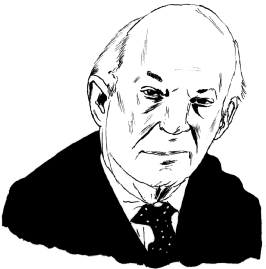
As the host of the Discovery Channel's "Most Evil," Columbia University psychiatry professor Michael Stone '54, MD '58, rates some of the world's most notorious killers on a scale of bad to worst
Cornell Alumni Magazine: Your show is based on your "gradations of evil" scale. How did you come up with it?
Michael Stone: In 1987, I was a witness in a case involving Jeffrey MacDonald, who was in prison for killing his pregnant wife and two daughters; he was suing Joe McGinniss, who had written the book Fatal Vision, for defamation of character. I was called in on behalf of McGinniss, and I wanted to show the jury where the crime fit in the grand scheme of inhumane acts. At the far end, on the not-so-bad side, was Jean Harris, who killed her lover, the "Scarsdale Diet" doctor, when she discovered her rival's panties in his drawer. At the other end, I put Ian Brady, who tortured children that he and Myra Hindley had captured on the moors in England and recorded their screams to use as an aphrodisiac. I began filling in the spaces, trying to order the murderers that I was reading about in true crime books. I ended up with twenty-two categories, where Number One was justifiable homicide, Number Two was Jean Harris's crime of passion, and twenty-two was the awfulest of the awful.
CAM: How come Charles Manson—who seems like the epitome of a crazed killer—only got a fifteen?
MS: I interviewed some of the women in the Manson case, and when I look at it now, I might assign him a higher number even though he didn't kill anyone with his bare hands— because, like Hitler, he empowered and persuaded others to do horrible things.
CAM: Does Hitler get a twenty-two?
MS: Hitler is political, and I don't get into that. The use of the word "evil" in political situations is much different because you have one side calling the other evil, and it's left to the judgment of history where evil really lay. In the case of Hitler, there isn't much question. But Osama Bin Laden thinks the West is evil and we consider him evil. It's a separate universe of discourse.
CAM: Is interviewing murderers at the "more evil" end of the scale like talking to any patient, or is it more disturbing?
MS: The first couple were disturbing. I wasn't used to it, and these were pretty vicious guys. Interviewing a death row inmate by telephone with three inches of Plexiglas between you was a new experience. I knew I was protected, so I wasn't afraid—it's just what it's like to interview one of these spooky characters. However, it became quite routine, and I was comfortable and could be myself.
CAM: Why are people so fascinated by these kinds of shows? Why are TV crime dramas and murder mysteries so popular?
MS: I look at it from an evolutionary standpoint. When we crawled out of the savanna 50,000 years ago, we had evolved from an area where we constantly had to be on the lookout for things that could hurt us, like saber-toothed tigers and mammoths. So our brains are wired to notice crocodiles and snakes more than guns and cigarettes, which take a much higher toll on our species. We also have a vocabulary that is much more ample with respect to negative things than positive things. I once did an exercise of finding all the negative adjectives I could—deceitful, dishonest, back-stabbing—and all the positives, like courageous and honest. I ended up with 500 negative words and 100 positive words, showing how attuned we are to what is hurtful.
CAM: What made you interested in studying criminals in the first place?
MS: When I was a kid I kept skipping grades—I was only ten in the seventh grade—so I was bullied a lot. I had a taste of being hurt. Once, a very big, strange boy invited me to his home and tried to strangle me. To this day I don't know how I fought him off. That probably triggered my interest in the bad things that people do to others—because I was one of the others.
CAM: You're an opera patron; you've studied Sanskrit, Hebrew, Latin, Greek, German, and French; you collect antiquarian books about psychiatry. So why is a pop-culture medium like TV interesting for you?
MS: Ordinarily, it's not. But because it gets noticed and it gets my viewpoint across to a larger audience, I think it has a use. I'm not interested in the sensational, which is the focus of some of the crime shows that I don't watch. I'm interested in the string of factors—heredity, bad environment, head injury—that leads somebody to do violent crimes that we pin the label "evil" to.
CAM: So how do you define evil?
MS: Evil is an emotion. When you talk about certain things, people will gasp, and that response is almost inevitably accompanied by, "That's evil." That's my definition, actually: that which causes a breath-taking experience of awfulness on the part of an ordinary person. For instance, when I was in Australia, there was a patient where I was consulting whose mother was a religious fanatic who would "purify" her by locking her in the closet overnight so she couldn't eat or have any waste product in her, and then would scrub her private parts with Brillo before church on Sunday.
CAM: [Interviewer gasps.]
MS: See—there's your response.
CAM: You got me. So what's it like to have such awful things living in your head?
MS: Well, in a way it's just curiosity. It doesn't trouble me. I'm not involved in the front lines of capturing serial killers. I interview these people after they're captured; I don't see the bodies on the ground as the FBI does.
CAM: You've said that evil is a purely human phenomenon.
MS: If a cat eats a mouse, it's just having dinner. We are the only ones that know about death and the suffering we inflict on others. I've done a lot of work on what religious leaders and philosophers have called "evil" over the millennia and find it totally useless. They talk about whether God, being omnipotent, can allow evil and if so how does it come about? This doesn't get you anywhere. Philosophers and theologians never get down to cases. Dante comes a little closer, and indeed my work is like Dante revisited in many ways. Dante has nine circles; I have twenty-two compartments.
— Beth Saulnier
Winged Mystery
Epidemic of bat deaths baffles scientists
In late March, vet professor John Hermanson hiked into an abandoned iron mine in the Adirondacks. Nearly a half-century has passed since the last miners hauled ore from deep within this mountain in northern New York, and during that time, a new ecosystem has emerged. Every autumn, as many as 50,000 Pipistrelle, little brown, big brown, Northern, and Indiana bats converge on the site. They mate and then hibernate, hanging shoulder to shoulder, often wrapped companionably in one another's paper-thin wings as they slumber through the winter. Beneath them, raccoons and insects scavenge in the guano.

But this winter, insectivorous bats in New York, Vermont, Connecticut, and Massachusetts started dying by the thousands, in a mysterious parallel to the seemingly unrelated colony collapse disorder that has afflicted honeybees in recent years. Named for the dusty fungus visible on the muzzles and wings of many of the affected animals, white nose syndrome (WNS) causes severe emaciation; many bats never rouse from hibernation and few survive. Since it was first documented at four upstate caves in the winter of 2006-07, WNS has killed more than a half-million of the small flying mammals native to the northeastern U.S.
With an entourage from Boston University and the New York State Department of Environmental Conservation (DEC), Hermanson had hiked deep into the mountain's interior in search of clues. "We went in believing this would be a clean cave," says the associate professor of anatomy, "and instead we found a couple of bats with white nose syndrome." If the numbers play out as they have at other sites where bats are afflicted with the mysterious condition, less than 10 percent of those who have wintered there in previous years could survive to return; those who do will likely be sickly and weak.

While the team Hermanson accompanied took a census, measured temperature and humidity, and documented geological features of the cave, John Whitaker Jr. '57, PhD '62, director of the Center for North American Bat Research and Conservation at Indiana State University, was combing through data he's collected over the last twenty years for clues to the condition of bats entering and exiting hibernation, hoping to establish a baseline for healthy autumn weight-gain. "What we don't know is what happened last fall," says Whitaker, co-author of Mammals of the Eastern United States. "Did they go in with their full amount of fat, or did they go in with very little fat? At any rate, mid-winter they don't have the fat to take them on through. That's the biggest question. The second is what is causing this."
Back in Ithaca, veterinary pathologist Beth Buckles '92 was tackling that issue, completing more than 100 post-mortem exams at the behest of DEC scientists who contacted Cornell's Vet college in January, when they confirmed that the epidemic had spread beyond the Capital Region to all but one of New York State's known hibernacula. "There's a lot of speculation," says Buckles, an assistant professor of biomedical sciences. In late April, as healthy bats began emerging from hibernation and heading for their maternity colonies and summer roosts—a migration of up to 250 miles—Buckles was no closer to a smoking gun; neither were her colleagues at more than fifteen government, university, and private labs. "A sick animal often loses weight," says Buckles, noting that the bats she's examined showed no signs of internal lesions or heightened inflammatory response and no sign of pesticide, heavy metal, or toxin residue. "We don't have a pathogen in hand to explain why these bats are dying, so we can't even say that this is an infectious disease."
In the absence of answers, scientists and policy makers have generated a trove of research questions to explore during the summer, strategizing about what data to collect through the fall, as the bats return to their hibernacula. "There could be a lot of interpretations," says Buckles. "Were they too late going in so they couldn't make it through the winter? Did something happen in the cave that caused them to use up their body fat stores more rapidly? Was a disease increasing their metabolism?" Other researchers have focused on the role of relative humidity inside affected caves, the synergy of decreased fat stores and immunosuppression, and the cumulative effects of increased pesticide use, either on the bats themselves or on their food supply.
The shortage of hard data has a lot of people deeply frustrated, admits Herman-son, who fields regular calls and e-mails from friends and colleagues searching for answers. Bat Conservation International founder and president Merlin Tuttle, who has raised money to fund the ongoing studies as well as a June meeting of scientists nationwide investigating WNS, expects the search for a solution will be a race against time. "Let's say it turns out to be a disease; it may be that the bats wouldn't have been susceptible if they hadn't been short of food or impacted by pesticides that reduced their resistance or their ability to hibernate effectively," he says. "I suspect that we're going to find multiple cumulative impacts that are bringing this about."
— Sharon Tregaskis
Fists of Fury
Engineer flexes her muscles on TV's 'American Gladiators'

Jamie Reed Kovac '01, MEng '02, never thought having her purse stolen would be her big break. Riding New Jersey Transit to her home in South Amboy from a club hockey practice, Kovac left the handbag—which contained both her video camera and her audition tape for the reality TV show "American Gladiators"—on the seat next to her. As the train came to a halt, a man walked by, snatched the purse, and took off.
Kovac chased him, flying down two flights of stairs and hurtling through traffic for a block and a half, she says, "screaming at him like a maniac" until he dropped the purse and fled. "Then I took the camera and taped the response of the conductor and everyone on the train who saw it happen," Kovac says. "I'm sure that helped guarantee me a spot on the show."
On "American Gladiators," contestants battle a team of muscle-bound "gladiators" in events like the Earthquake—in which competitors wrestle on an unstable ring hanging above a mat—and Hit and Run, where the contestants scramble across a bridge while the gladiators hurl 100-pound balls at them. Originally airing in the early Nineties, the show was revived last season by NBC. Kovac—who was, in fact, voted "most likely to be on 'American Gladiators' " in her high school yearbook—was one of the show's twelve gladiators, adopting the moniker "Fury." A former softball player and pole vaulter for Cornell, she has competed in bodybuilding and is active in mountain biking, windsurfing, rock climbing, snowboarding, and more.
Kovac has a day job as a structural engineer, and her future with "American Gladiators" is uncertain due to a knee injury she suffered during a first-season match. She started physical therapy two days after surgery but didn't return for the show's second season, which premiered in May. "It's something that I need in my life," says Kovac. "I don't just do things—I compete."
— Nick Corasaniti
The Deadly Arts
How a nice guy from New Jersey spawned a contract killer
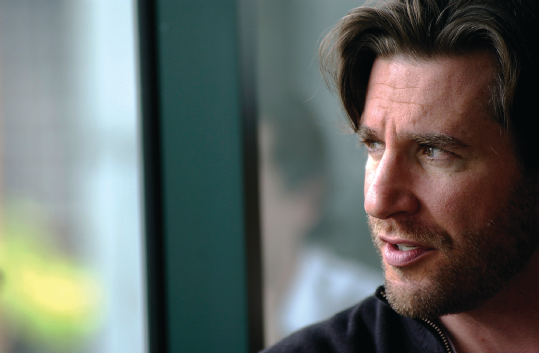
John Rain is a connoisseur of good jazz and single malt whisky. He travels the world—from the beaches of Bali and the boulevards of Paris to the high-rent districts of Tokyo and high-class casinos of Macau. He stays in fancy hotels, beds beautiful women, and gets paid handsomely for his expertise. Ah, but that expertise is killing—specifically, making death appear due to "natural causes." So he often finds himself targeted by assassins, whether he is going up against the CIA, Israel's Mossad, or the Japanese mafia. And he is constantly running counter-surveillance, moving from place to place, maintaining a life of carefully cultivated anonymity.
Rain is the creation of author Barry Eisler '86, JD '89, who has a few surface similarities to the protagonist he has maneuvered through six books since 2002—the love of jazz and whisky, for instance, and the black belt from the Kodokan International Judo Center in Tokyo. Both are former CIA, albeit in quite different capacities, and both had some military training. (Rain was in the U.S. Special Forces in Vietnam; Eisler got seven weeks of paramilitary instruction during his agency stint.) But Rain is a half-Japanese, half-Caucasian assassin with trust issues, while Eisler is a nice Jewish guy from suburban New Jersey, a husband and father. "He's more damaged," Eisler explains. "I haven't faced a lot of danger in my life." Still, he has long been intrigued by the possibilities.
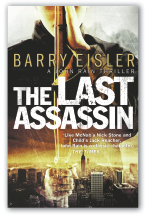
It started with Harry Houdini. At age ten, Eisler read a biography of the escape artist in which a police officer was quoted as saying, "It's fortunate that Houdini never turned to a life of crime because if he had he would have been difficult to catch and impossible to hold." Eisler realized that Houdini had skills the government doesn't want people to have—and that could make him dangerous. "I was fascinated by the notion that if you worked hard at it, you could actually acquire that forbidden knowledge," he says.
That led to a lifelong study of martial arts—from karate to ju-jitsu to boxing, which he practiced while earning his BA in psychology on the Hill. Eisler remained in Ithaca for law school, during which he began amassing a collection of books with titles like Twenty-one Techniques of Silent Killing, How to Disappear Completely and Never Be Found, and Contingency Cannibalism. "My wife [literary agent Laura Rennert '86] used to make me keep them in a box," says Eisler, "but when I got published she agreed I could put them on a shelf, figuring she could tell people it's just research."
Eisler's involvement with martial arts evolved into an interest in Japanese culture (he wrote a foreign policy column for the Daily Sun during law school). After graduating, he took a job with the CIA's Directorate of Operations, became fluent in Japanese, and set himself on a course toward an agency position in Japan. But after three years, still stateside, he left the CIA for an international law firm, followed by a stint as in-house counsel at a Japanese electronics company. Even the law, Eisler says, would later provide fodder for his death-defying assassin's frame of mind. "You do a lot of negotiating," he explains, "and you have to understand what the other side wants and what they're going to do to get it." While Eisler lived in Tokyo, his interests and expertise coalesced into the beginnings of a novel, Rain Fall. Eight years later, the book was published in Japan, which generated a bidding war in the U.S., allowing him to devote himself to writing full-time.
Rain's tools and techniques offered a hook for that first novel, but his inner conflicts—he struggles with the fact that killing comes so easily to him, and he is constantly trying to reconcile his desire for companionship with his inherent distrust of everyone—make him a complex character. He is an assassin battling his instincts, yearning to get out of the business, struggling with his mixed heritage. The recipe seems to be working. In a review of Rain Storm, his second book, Entertainment Weekly said, "If Quentin Tarantino ever got to take a crack at the James Bond franchise, chances are the resulting film would resemble one of Eisler's novels about John Rain." Rain is, in fact, bound for the big screen: Sony Pictures Entertainment Japan has acquired the film rights to Rain Fall, and is in preproduction with actor Gary Oldman signed to play William Holtzer, Rain's CIA nemesis. Eisler's sixth Rain novel, Requiem for an Assassin, published last year, debuted at nineteen on the New York Times best-seller list.
His seventh book, due out in 2009, is a stand-alone thriller set primarily in the San Francisco Bay Area, where Eisler and his family now live. He doesn't rule out a future Rain prequel or perhaps a spinoff involving one of the three still-breathing companions whom Rain has allowed into his inner circle. For now, however, Eisler has retired his assassin. But as John Rain has discovered, killers never really retire.
— Brad Herzog '90
Broadcasting for Beasts
Radio vet treats Chihuahuas and toads and cockatiels, oh my!
When Elizabette Heilberg Cohen was three years old, her cocker spaniel was hit by a car. "I'll never forget it," she says. "The upstairs window was open, and we heard a horrible screech. I looked out the window, and my grandmother quickly went to cover up my eyes—but not before I saw our dog lying in the street in front of a car." Fortunately, the spaniel, Bawbee, suffered just a broken leg. With that, a veterinarian was born.

A vet for two decades, Cohen, DVM '88, has expanded her clinical practices in New York City and Long Island with a self-published book, Most of My Patients Wear Fur, and a regular sixty-second radio report, "Healthy and Happy Pet" on WCBS 880 AM. The news station broadcasts the spot (and streams it on the Internet) four to six times on weekends. Heard in New York, New Jersey, Connecticut, and Pennsylvania, Cohen's show offers advice for pet owners. "My point is to help animals," she says. "When you educate the owners, you help the animals."
Topics range from how to prevent liver, heart, and kidney disease by brushing a dog's teeth daily to keeping pets cool during hot weather. "It's OK to give your dog or cat vanilla ice cream," Cohen says, or an ice cube of beef or chicken broth. To prevent sunburn and skin cancer, owners can color their dog's pink nose with indelible black marker, she says, though she notes, "It takes time to wear off."
Cohen has two dogs: Allie, a seventeen-year-old black Labrador retriever, and Roxie, a three-year-old rottweiler. But she cares for all kinds of small animals. She has extracted a rock from a toad's stomach ("Some idiot in a pet shop told the owner that he could put rocks in the tank—which was a big mistake") and removed a tumor from the wing of a nineteen-year-old cockatiel.
Perhaps her most unusual case involved a brown Chihuahua. A woman came to her clinic with the dog, which had deep gashes in its back—from an attack by a red-tailed hawk. The owner had been walking the dog in the park when the bird swooped down and grabbed it. "The dog was airborne," Cohen says. "These are birds of prey, and the Chihuahua was pretty much the size and color of a rabbit. Had she not had the dog on the leash—which she was holding on to for dear life—that dog would have been lunch."
— Susan Kelley


